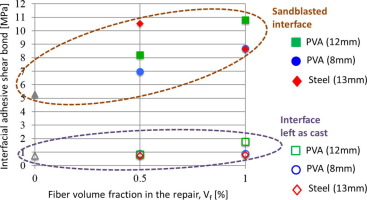Construction and Building Materials ( IF 7.4 ) Pub Date : 2018-01-08 , DOI: 10.1016/j.conbuildmat.2017.12.140 Cristina Zanotti , Giulia Rostagno , Brian Tingley

|
While intensive structural and non-structural repair is required worldwide to compensate the current infrastructure deficit, repair effectiveness is jeopardized by poor durability, compatibility, and bond. Benefits of fiber reinforcement in concrete repairs are remarkable as durability is enhanced and the effect of poor compatibility can be mitigated. Furthermore, fibers’ potential to improve concrete-concrete bond, a crucial property in repair applications, has been demonstrated. Only a few studies, however, are available on the effect of fibers on substrate-repair bond and additional analysis form different bond tests, fiber reinforcements, and substrate treatments are required to fully utilize such benefits in repair applications.
In this study, substrate-repair shear bond strength in fiber reinforced repair mortars is investigated. Based on previous encouraging results on 8 mm long Poly-Vinyl-Alcohol (PVA) fibers, PVA fibers with different lengths (8 and 12 mm) and 13 mm long steel fibers are compared. Two fiber volume fractions, equal to 0.5% and 1% are applied beyond the control condition (plain mortar). While results currently available are focused on roughened substrates, sandblasted substrates and substrates left as-cast are considered in these experiments. Substrate-repair bond strength is assessed through Modified Slant Shear Cylinder (MSSC) test with different bond plane inclinations, corresponding to different normal-shear stress ratios. Adhesion strength and friction coefficient, two parameters inherently characterizing substrate-repair bond, are assessed. The bond enhancing mechanisms offered by the different types of fibers and their correlation to surface treatment are discussed. Variations of indirectly determined coefficients are statistically validated through a permutation technique applied to the 170 samples tested overall.
中文翻译:

通过修复中的纤维增强来增强界面胶粘剂结合强度的进一步证据
尽管在世界范围内都需要进行密集的结构和非结构修复,以弥补当前基础设施的不足,但是由于耐久性,兼容性和粘合性差,修复效果受到了损害。纤维增强在混凝土维修中的好处非常明显,因为可以提高耐久性,并可以减轻相容性差的影响。此外,已证明纤维具有改善混凝土与混凝土粘结的潜力,这是修补应用中的关键性能。但是,只有很少的关于纤维对基材修复粘合的影响的研究,并且需要通过不同的粘合测试进行额外的分析,需要进行纤维增强和基材处理,才能在修复应用中充分利用这些益处。
在这项研究中,研究了纤维增强修补砂浆中的基层修补剪切粘结强度。根据先前在8毫米长的聚乙烯醇(PVA)纤维上获得的令人鼓舞的结果,比较了不同长度(8和12毫米)的PVA纤维和13毫米长的钢纤维。超出控制条件(普通砂浆)使用两种纤维体积分数,分别为0.5%和1%。尽管目前可获得的结果集中在粗糙的基材上,但在这些实验中考虑了喷砂基材和铸态的基材。底材修复的粘结强度通过改进的斜切圆柱体(MSSC)测试进行评估,该测试采用不同的粘结平面倾斜度,对应于不同的法向剪切应力比。评估了粘合强度和摩擦系数,这是固有的基材修复键的两个参数。讨论了由不同类型的纤维提供的键增强机理及其与表面处理的关系。间接确定的系数的变化通过对整个170个测试样本应用的置换技术进行统计验证。











































 京公网安备 11010802027423号
京公网安备 11010802027423号